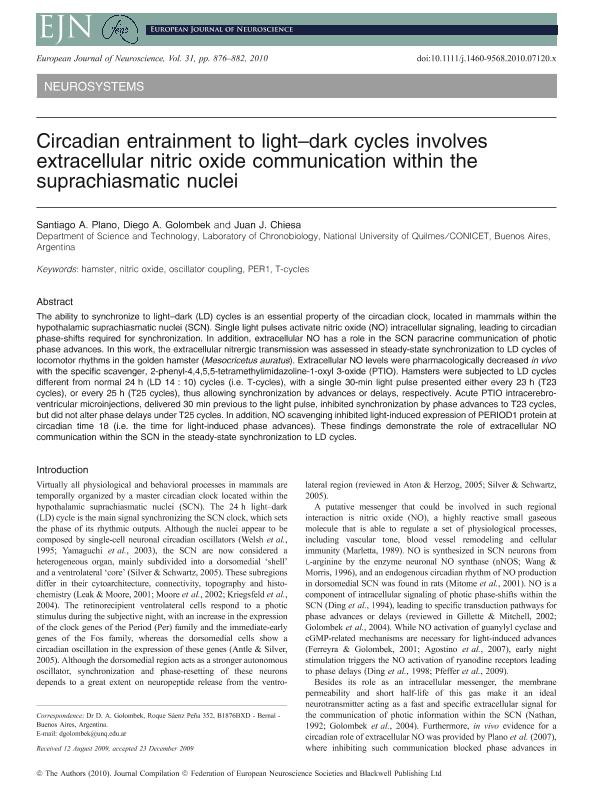Mostrar el registro sencillo del ítem
dc.contributor.author
Plano, Santiago Andrés

dc.contributor.author
Golombek, Diego Andrés

dc.contributor.author
Chiesa, Juan José

dc.date.available
2018-07-31T19:01:08Z
dc.date.issued
2010-03
dc.identifier.citation
Plano, Santiago Andrés; Golombek, Diego Andrés; Chiesa, Juan José; Circadian entrainment to light-dark cycles involves extracellular nitric oxide communication within the suprachiasmatic nuclei; Wiley Blackwell Publishing, Inc; European Journal Of Neuroscience; 31; 5; 3-2010; 876-882
dc.identifier.issn
0953-816X
dc.identifier.uri
http://hdl.handle.net/11336/53640
dc.description.abstract
The ability to synchronize to light-dark (LD) cycles is an essential property of the circadian clock, located in mammals within the hypothalamic suprachiasmatic nuclei (SCN). Single light pulses activate nitric oxide (NO) intracellular signaling, leading to circadian phase-shifts required for synchronization. In addition, extracellular NO has a role in the SCN paracrine communication of photic phase advances. In this work, the extracellular nitrergic transmission was assessed in steady-state synchronization to LD cycles of locomotor rhythms in the golden hamster (Mesocricetus auratus). Extracellular NO levels were pharmacologically decreased in vivo with the specific scavenger, 2-phenyl-4,4,5,5-tetramethylimidazoline-1-oxyl 3-oxide (PTIO). Hamsters were subjected to LD cycles different from normal 24 h (LD 14 : 10) cycles (i.e. T-cycles), with a single 30-min light pulse presented either every 23 h (T23 cycles), or every 25 h (T25 cycles), thus allowing synchronization by advances or delays, respectively. Acute PTIO intracerebroventricular microinjections, delivered 30 min previous to the light pulse, inhibited synchronization by phase advances to T23 cycles, but did not alter phase delays under T25 cycles. In addition, NO scavenging inhibited light-induced expression of PERIOD1 protein at circadian time 18 (i.e. the time for light-induced phase advances). These findings demonstrate the role of extracellular NO communication within the SCN in the steady-state synchronization to LD cycles.
dc.format
application/pdf
dc.language.iso
eng
dc.publisher
Wiley Blackwell Publishing, Inc

dc.rights
info:eu-repo/semantics/openAccess
dc.rights.uri
https://creativecommons.org/licenses/by-nc-sa/2.5/ar/
dc.subject
Hamster
dc.subject
Nitric Oxide
dc.subject
Oscillator Coupling
dc.subject
Per1
dc.subject
T-Cycles
dc.subject.classification
Bioquímica y Biología Molecular

dc.subject.classification
Ciencias Biológicas

dc.subject.classification
CIENCIAS NATURALES Y EXACTAS

dc.title
Circadian entrainment to light-dark cycles involves extracellular nitric oxide communication within the suprachiasmatic nuclei
dc.type
info:eu-repo/semantics/article
dc.type
info:ar-repo/semantics/artículo
dc.type
info:eu-repo/semantics/publishedVersion
dc.date.updated
2018-07-30T15:41:28Z
dc.journal.volume
31
dc.journal.number
5
dc.journal.pagination
876-882
dc.journal.pais
Reino Unido

dc.journal.ciudad
Londres
dc.description.fil
Fil: Plano, Santiago Andrés. Consejo Nacional de Investigaciones Científicas y Técnicas; Argentina. Universidad Nacional de Quilmes. Departamento de Ciencia y Tecnología. Laboratorio de Cronobiología; Argentina
dc.description.fil
Fil: Golombek, Diego Andrés. Consejo Nacional de Investigaciones Científicas y Técnicas; Argentina. Universidad Nacional de Quilmes. Departamento de Ciencia y Tecnología. Laboratorio de Cronobiología; Argentina
dc.description.fil
Fil: Chiesa, Juan José. Consejo Nacional de Investigaciones Científicas y Técnicas; Argentina. Universidad Nacional de Quilmes. Departamento de Ciencia y Tecnología. Laboratorio de Cronobiología; Argentina
dc.journal.title
European Journal Of Neuroscience

dc.relation.alternativeid
info:eu-repo/semantics/altIdentifier/doi/https://dx.doi.org/10.1111/j.1460-9568.2010.07120.x
dc.relation.alternativeid
info:eu-repo/semantics/altIdentifier/url/https://onlinelibrary.wiley.com/doi/abs/10.1111/j.1460-9568.2010.07120.x
Archivos asociados
